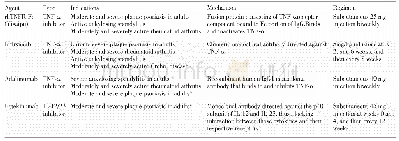《Table 1.Similarity properties of four typical shots at different laser energies and different dista
 提示:宽带有限、当前游客访问压缩模式
提示:宽带有限、当前游客访问压缩模式
本系列图表出处文件名:随高清版一同展现
《Laboratory radiative accretion shocks on GEKKO XⅡ laser facility for POLAR project》
The similarity properties are presented in Table 1.In order to evaluate the hydrodynamic parameters of the postshock region,the quantities are estimated when the reverse shock is located at 200μm from the obstacle,according to the simulations.The characteristic parameters(plasma flow velocity vflow,post-shock densityρpsand temperature Tps)and the cooling parameter are compared with the data from the polar prototype AM Herculis star in high-state accretion[24].The Mach number(M)of the reverse shock is defined as(vflow-vshock)/cs,ps.The cooling parameter(χ)in the post-shock region characterizes the balance between the radiative processes and the hydrodynamics in the radiative zone[12],and then the astrophysical relevance of such laboratory targets.In such a process where radiation effects are of some relevance,the cooling parameter offers a qualitative hydrodynamic scaling.However,the atomic physics processes might only be partially addressed by such a macroscopic dimensionless number.The cooling parameter is defined as the ratio between the cooling time and the dynamical time in the post-shock region.The dynamical time is defined as the ratio of the length of the post-shock region to the sound velocity.The cooling time is determined as the ratio of the internal energy density to the emissivity of the medium.Due to the relatively low temperature and high density of the laboratory plasma compared to the astrophysical regime,the plasma emissivity is not due to the bremsstrahlung cooling.Thus the laboratory emissivity of the medium is given by~κPσT4,whereκPandσare respectively the Planck mean opacity and the Stefan–Boltzmann constant.
| 图表编号 | XD0027422200 严禁用于非法目的 |
|---|---|
| 绘制时间 | 2018.06.30 |
| 作者 | L.Van Box Som、E.Falize、M.Koenig、Y. Sakawa、B. Albertazzi、P. Barroso、J.-M. Bonnet-Bidaud、C. Busschaert、A. Ciardi、Y.Hara、N.Katsuki、R.Kumar、F.Lefevre、C.Michaut、Th. Michel、T.Miura、T. Morita、M.Mouchet、G. Rigon、T.Sano、S.Shiiba、H. Shimogawara、S. Tomiya |
| 绘制单位 | CEA-DAM-DIF、LERMA,Sorbonne Universite,Observatoire de Paris,Universite PSL,CNRS、CEA Saclay, DSM、Irfu、Service d'Astrophysique、CEA-DAM-DIF, F-91297 Arpajon、CEA Saclay, DSM、Irfu、Service d'Astrophysique、LULI-CNRS,Ecole Polytechnique,CEA:Universite Paris-Sac |
| 更多格式 | 高清、无水印(增值服务) |
查看“Table 1.Similarity properties of four typical shots at different laser energies and different distances from the obstacl”的人还看了
-

- 表2 不同反应温度制备C/C-Si C复合材料的性能Table 2 Properties of C/C-Si C composites fabricated at different reaction temperatures





![表不同温度及频率下电树枝形态[19]Tab.Typical structure of electrical trees at different temperatures and frequencies[19]](http://bookimg.mtoou.info/tubiao/gif/DQZH201811003_23500.gif)